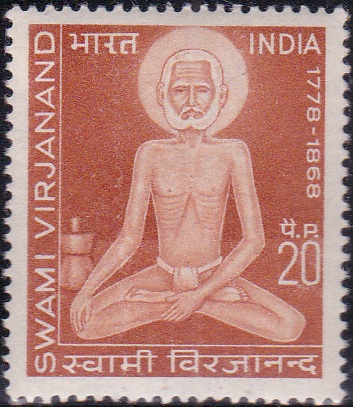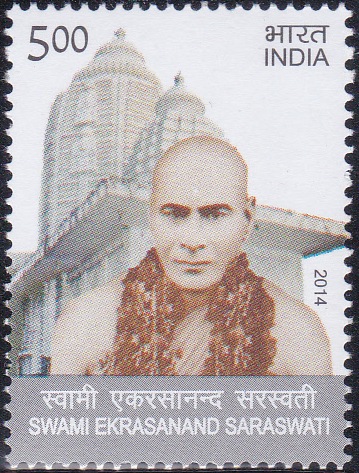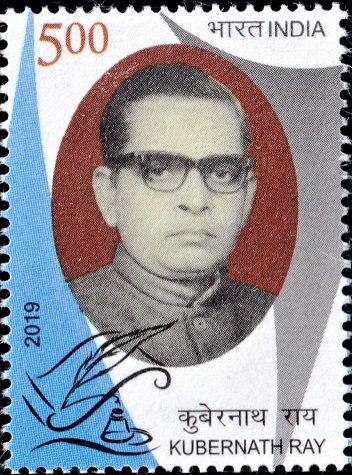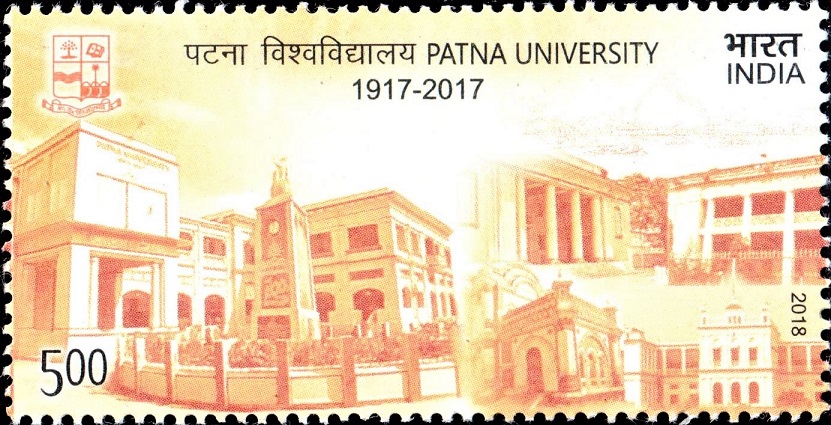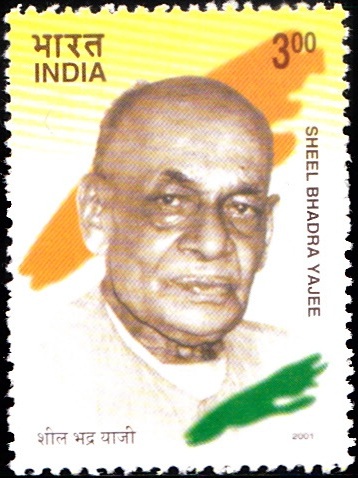
Swami Sahajanand Saraswati
A commemorative postage stamp on Sahajanand Saraswati, an Indian ascetic, nationalist and peasant leader, founder of the All India Kisan Sabha :

 Issued by India
Issued by India
Issued on Jun 26, 2000
Issued for : The Department of Posts is happy to issue a commemorative stamp in honour of Swami Sahajanand Saraswati.
Credits :
Stamp : Sankha Samantha
FDC : Based on material furnished by the Sponsors.
Cancellation : Alka Sharma
Type : Stamp, Mint Condition
Colour : Two Colour
Denomination : 300 Paise
Overall size : 2.9 x 3.9 Cms.
Printing size : 2.9 x 3.9 Cms.
Perforation : 13.5 x 13.5
Paper : Matt Chromo
Stamps Printed : 0.4 Million
Number per issue sheet : 40
Printing Process : Photo Offset
Printer : Calcutta Security Printers Ltd.
Name : Naurang Rai
Born on Feb 22, 1889 at Deva, Dullahpur, Ghazipur, United Province, British India
Died on Jun 25, 1950 at Patna, Bihar, India
About :
- Swami Sahajanand Saraswati (1889-1950) was a sanyasi as well as a revolutionary, who dedicated his life to the cause of political and economic independence of the Indian people.
- Born in the district of Ghazipur of Uttar Pradesh, he was brilliant as a young student. Renouncing his home and family and adopting the way of asceticism, he moved to Varanasi where he devoted nine years to the study of Sanskrit and Hindu philosophy. The struggle for independence took stronger form with the advent of Mahatma Gandhi to the country. Gandhiji‘s impassioned speeches inspired the nation in the non-cooperation and civil disobedience phases of the National Movement and Swami Sahajanand Saraswati was deeply influenced by the Mahatma‘s call to the nation. He went on to play a prominent role in organising the non-cooperation movement in the Shahabad district of Bihar and the adjoining district of Ghazipur in Uttar Pradesh. By addressing public meetings, rousing the masses to actively participate in the movement and collecting the Tilak Swaraj fund, he made significant contributions to spreading the movement for which he was arrested immediately and sentenced to undergo rigorous imprisonment for one year.
- From 1924 to 1928 his activities centered on the propagation of Khadi and prohibition, the two most important items of Mahatma Gandhi‘s constructive programme. Simri village in Shahabad district and Bihata in Patna district became two important centres of his activities. He established a Khadi weaving centre at Simri and an Ashram for political and Sanskrit teaching at Bihata. As a recognition of his work for the Congress, he was first elected a member of the UPCC and then of the BPCC and the AICC.
- While advocating the abolition of the zamindari system and creation of peasant proprietorship as the central slogans of agrarian reforms, he took up the burning issues of feudal oppression, such as forced labour, illegal exactions, evictions etc., for organising Kisan resistance and struggle. By the mid-thirties the Kisan movement in Bihar under his inspiring and militant leadership became a powerful political force which worked for the defeat of landlords by the Congress in the 1936 elections to the Bihar Legislative Assembly. The first Congress Ministry which was formed in Bihar as a result of the 1936 elections could not but undertake a number of tenancy reforms, bringing much needed relief to the newly awakened peasants.
- Swami Sahajanand was a powerful agitator and propagandist, and his speeches moved and moulded millions of peasants in the defence of their rights. Swamiji came to be addressed as ‘Kisan Pran‘ (life of Kisans) by his Kisan Sabha followers. Such was his popularity that Sahajanand Day was observed throughout Bihar on 19 April 1940 in protest against his arrest. In 1949, only a year before his death, the country honoured him by celebrating his Diamond Jubilee and presenting him a purse of Rs. 60,000/- on the occasion.
- He was also a forceful writer and ran the Hindi weekly Hunkar from Patna. His noted works on peasant problems and struggle include ‘The Other Side of the Shield‘, ‘Rent Reduction in Bihar: How it Works‘, ‘Gaya Ke Kisano Ki Karun Kahani‘ (Pitiable stories of the Kisans of Gaya), ‘How the Kisans Fight‘ and ‘Kisan Sabha Ke Sansmaran‘ (Reminiscences of the Kisan Sabha).
- Text : Based on material furnished by the Sponsors.



